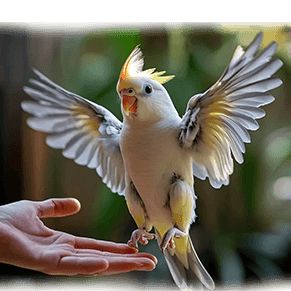How to Train Your Parrot: A Comprehensive Guide
Parrots are highly intelligent and social animals, making them fantastic pets but also challenging to train. Their complex behaviors, vocal abilities, and long lifespan mean they need consistent mental and physical stimulation. Proper training is essential for their overall well-being and to create a strong bond with their human companions. Whether you’re teaching your parrot basic commands, tricks, or improving their behavior, training should be fun, patient, and consistent.
Why Training is Important
Training not only helps manage your parrot’s behavior but also enriches their lives. It strengthens your bond and gives them the mental stimulation they crave. Without enough activity, parrots can become bored, stressed, and even aggressive.

Training is essential for:
- Behavior Management – Training helps prevent and correct unwanted behaviors like biting, screaming, or feather plucking.
- Mental Stimulation – Parrots are smart and need constant challenges to keep their minds sharp.
- Bonding – Training sessions help build trust between you and your parrot.
- Safety – Teaching your parrot to come when called or step up on command can prevent accidents.
Training Basics: Getting Started
Before diving into specific tricks or commands, it’s important to set the stage for successful training. Here are some basic tips:
- Positive Reinforcement – Parrots respond best to positive reinforcement, which means rewarding good behavior with treats (Amazon affiliate link), praise, or attention. Avoid punishment, as it can create fear or anxiety.
- Consistency – Use the same words, tone, and hand signals during training. This helps your parrot understand what you’re asking.
- Short Sessions – Parrots have short attention spans, so keep training sessions to about 10-15 minutes. Training should be fun and engaging, not exhausting.
- Timing is Key – Immediately reward the desired behavior so your parrot connects the action with the reward. Parrots have excellent memories, but they learn faster with quick feedback.
- Be Patient – Parrots can be stubborn, and some behaviors may take longer to learn than others. Stay calm, and don’t get frustrated if progress is slow.
Commands to Teach Your Parrot
Step-Up Command
The “Step-Up” command is the most basic and useful command for parrots. It teaches them to step onto your hand or a perch on command.
How to Teach It
- Gently press your finger or perch against your parrot’s lower belly, just above the legs.
- Say “Step up” in a firm but friendly tone.
- As soon as your parrot steps onto your hand, reward them with a treat and praise.
- Repeat this process until they associate the command with the action.
Tips
- Don’t force your parrot if they’re hesitant. With patience, they’ll learn to trust the process.
- Practice this frequently, as it’s the foundation for most other behaviors.
Recall Training
Recall training involves teaching your parrot to come to you when called. This is not only useful but also an important safety skill.
How to Teach It
- Start by practicing in a small, enclosed area. Hold a treat and call your parrot’s name, followed by the word “Come.”
- When your parrot moves toward you, reward them with the treat and give praise.
- Gradually increase the distance between you and your parrot as they get better at coming when called.
Tips
- Start with short distances before progressing to longer ones.
- Use high-value treats to make recall training extra rewarding.

Teaching Tricks
Parrots can learn fun tricks like waving, shaking hands, or even talking. These tricks provide great mental stimulation and are a fun way to interact with your bird.
How to Teach It
- Choose a simple trick, like waving. Hold your parrot’s foot and gently lift it while saying “Wave.”
- After each successful lift, reward your parrot with a treat and praise.
- Repeat until your parrot lifts their foot on command without assistance.
Tips
- Use a clicker if you’re familiar with clicker training. The click marks the desired behavior.
- Always end training sessions on a positive note, even if progress is slow.
Potty Training
Potty training your parrot can make life easier for both you and your feathered friend.
How to Teach It
- Observe when your parrot is about to go to the bathroom (they often squat slightly).
- When you see the sign, say a cue like “Go potty” and immediately take them to their designated spot (a cage perch or potty station).
- Once they’ve gone to the bathroom in the right spot, reward them with a treat.
- Repeat this process, being consistent with the spot and the cue.
Tips
- Be patient—this can take time, as parrots don’t naturally understand potty training like some mammals do.
- Never scold your parrot for accidents. Use positive reinforcement when they do it right.

Common Training Challenges
Even with the best approach, you may encounter some challenges while training your parrot. Here’s how to handle a few common issues:
- Biting – Parrots may bite out of fear, frustration, or overstimulation. Avoid reacting dramatically, as this can reinforce the behavior. Instead, calmly end the interaction and try again later. Train the “Step-Up” command to establish boundaries.
- Screaming – Screaming is a natural way for parrots to communicate, but excessive noise can be managed by ignoring the behavior and rewarding quiet moments instead. Never yell back, as this can encourage more screaming.
- Feather Plucking – Feather plucking can be a sign of stress or boredom. Provide plenty of mental and physical stimulation and consult a vet if the issue persists.
Advanced Parrot Training
Once your parrot has mastered the basics, you can move on to more advanced behaviors like:
- Talking – Many parrot species, particularly African Greys and Amazons, are famous for their ability to mimic human speech. Start by repeating simple words or phrases and reward your parrot when they try to mimic you.
- Target Training – Using a target stick, you can teach your parrot to follow the stick and move to specific areas. This is useful for moving your parrot around the house or into their cage.

Training Tools
There are a few tools that can make parrot training easier:
- Clicker – A small clicker is a great tool for marking good behavior with precision. Every time your parrot does something right, click the device and immediately give a reward. (Amazon affiliate link)
- Target Stick – A long stick or training rod can be used for teaching parrots to move towards a designated spot or object.
- Training Perches (Amazon affiliate link) – Separate training perches can create a distraction-free environment that helps parrots focus on learning.
- Reading materials – “Parrot Training: A Guide to Taming and Gentling Your Avian Companion” (Amazon affiliate link) by Bonnie Munro Doane.
Conclusion
Training your parrot is an ongoing process that requires patience, consistency, and plenty of positive reinforcement. Whether you’re teaching basic commands like “Step-Up” or more advanced tricks, the key is to make training sessions enjoyable and rewarding for your bird. By building a trusting relationship, you’ll have a happier, healthier parrot that is well-behaved and bonded with you for life.
Affiliate Disclosure
This post may contain affiliate links, which means I earn from purchases made through links. Please see the privacy policy page for more details.





